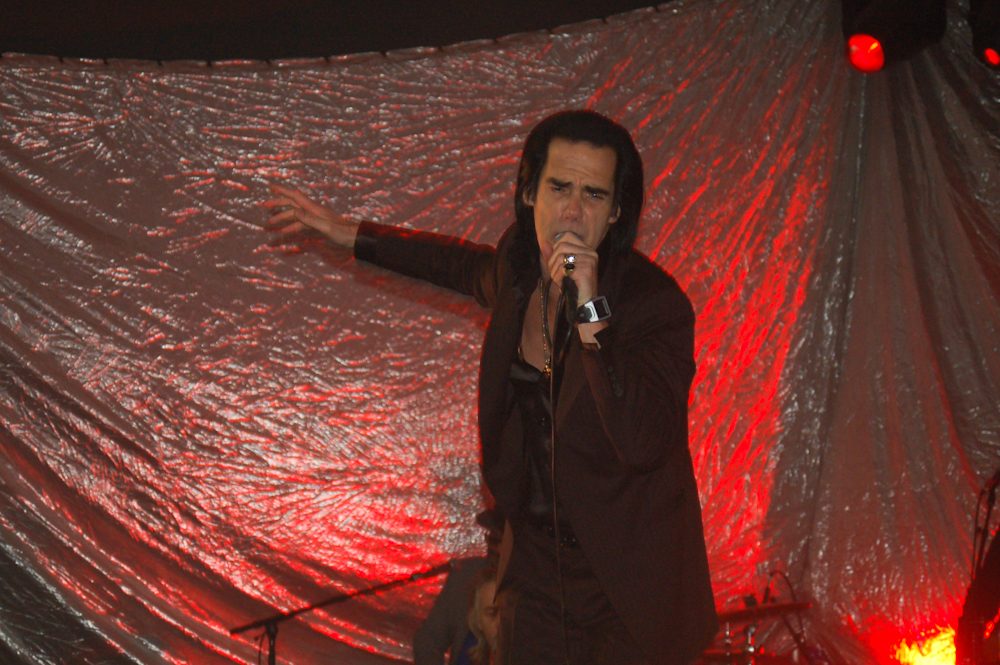

As a crooner, troubadour, screenwriter, lyricist, novelist–whatever you want to label him (and likely fail in doing so), Nick Cave can in broadest terms be defined as a storyteller. Dark, witty and often inappropriately funny, the stories he weaves and adapts transmit singularly cogent darkness, his weathered vocal cords a lightning rod for his experiences. On what was his last date of this leg of the tour, a sold-out house had the unique opportunity to ask him anything, often revealing their own vulnerabilities in the process.
This “experiment in intimacy,” as he put it, has been touring for some time now, and will continue in Europe in 2020. The at-times awkward and weird moments were handled with a gentle grace; he unhesitantly tackled the subjects of addiction and rape as fluidly as he fielded questions about inspiration and songcraft. “Suspend judgment,” he said at the get-go. “It can get weird.”
The experiment consisted of a single grand piano on a stage shared with eight or ten candle-lit tables that were occupied by lucky attendees (how they got to be there would be addressed later). The house and stage lights dimmed to near pitch-black as the brooding spoken words of 2016’s “Steve McQueen” echoed through the hall. But before the track even ended it was drowned out by applause as the white cuffs and collar of Cave’s black suit appeared and approached the piano. After a brief silence the sentimental romance of “The Ship Song”’s gentle chords reverberated through the cavernous hall, complemented by Cave’s equally cavernous voice, combining like a gritty-sweet ooze colored by the painful beauty we’ve come to expect. “This is an in-conversation event, so come on.” Laughter.
Holding court for the next two hours, Cave answered questions from every corner of the hall, signaled by ushers waiving flashing red wands like runway marshallers. The system made for a smooth Q&A. A flashing red light meant a mic was already in hand, question ready, let’s go. More often than not the answer would bring to mind a song. Cave would return to the piano, shuffle through sheaves of staff paper until he found the right one, and perform one of his many classics, laid bare. “Jubilee Street,” which when performed with the Bad Seeds has become a powerful climax in their live sets, became a thoughtful reflection. But every song he played, especially “Into My Arms,” shrank the room, closing the gap presented by the oxymoronic concept of an “intimate evening” held in a gaping symphony hall.
Drug abuse, the fits and starts of attaining sobriety, the process of creating art from a failed romance, how overcoming the death of his son helped him find new contexts for older songs–nothing was off the table. Although it could get dark, and it did, in fact, get weird, a thread of inspiration ran through the conversation. A man who worked on death row offered insights when discussing Cave’s “The Mercy Seat” (which he then played). A young woman shared her struggles with addiction, and Cave responded with his. When asked why he started doing these in-conversation events, why the change, he said without hesitation it was the death of his son. Has sobriety changed his artmaking? Of course, but it’s gotten so much better, defying the fears he’d had brewing in him over the ten years it took to kick his habit.
As the evening wrapped up, the on-stage tables were finally addressed by a 20-something near the stage. “What do you have to do to sit up there?” Cave replied that he was pretty sure they’re randomly selected, and then invited him to come up. Rather than take a seat at the table, the young man took a seat at the piano instead, as Cave fielded the final question. He got up as Cave sat down to play “Stagger Lee,” but Cave gently patted the extra space on the bench, and playfully serenaded the lucky boy with one of the most violent songs ever written, hilariously pantomiming the four gunshots to the boy’s head. It’s very likely that no one there would hesitate to take his place.
Set list:
Photo Credit – Raymond Flotat
